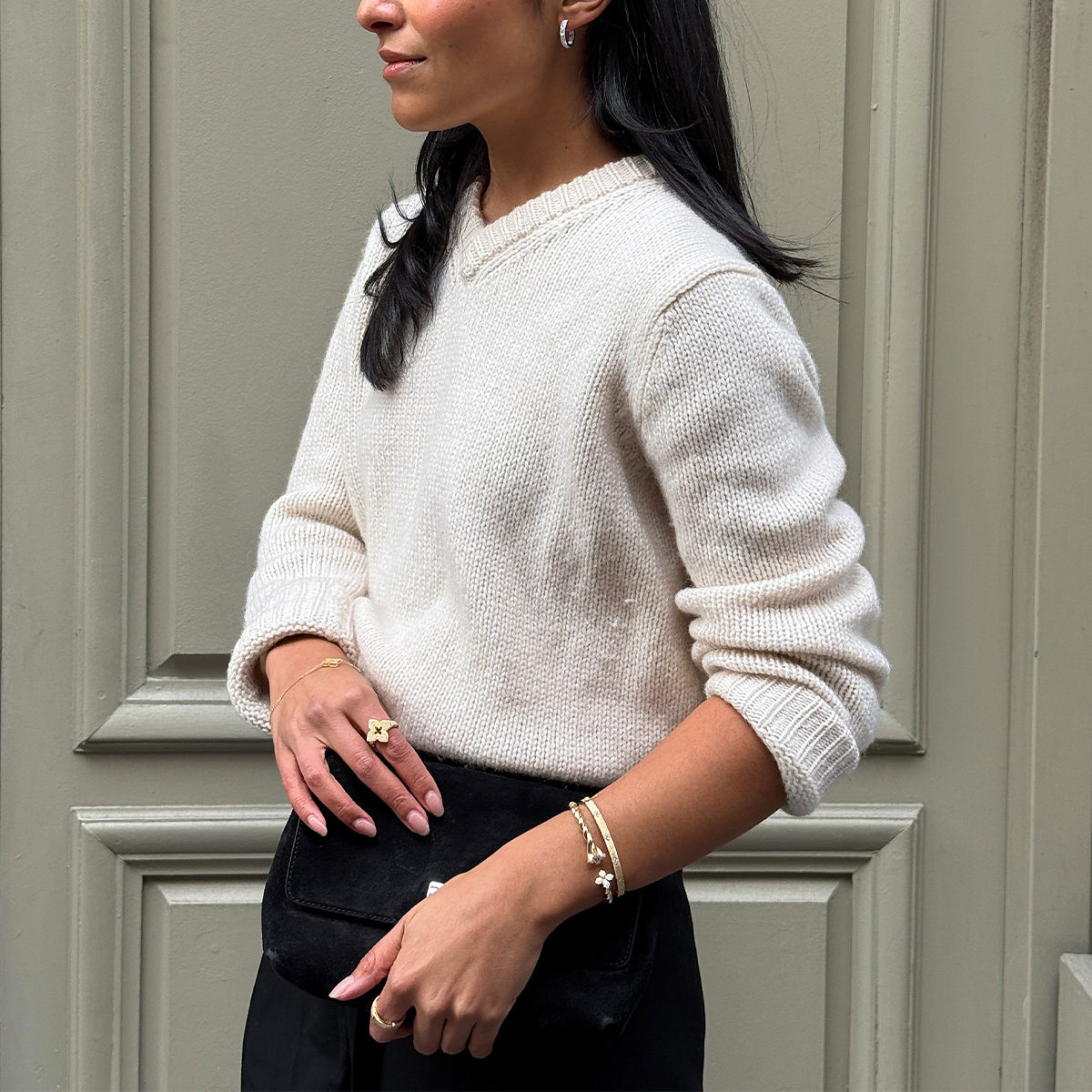Hollywood's Costume Designers Share the Secrets to Creating Authentic '40s Style
If you haven’t already finished watching Netflix’s Hollywood, don’t worry—there are no spoilers ahead—and if you haven’t even started, prepare to carve out a block in your schedule because you’ll want to binge this fanciful-yet-fulfilling eight-episode miniseries immediately.
You don’t have to be a die-hard fan of Ryan Murphy or his remarkable cast of recurring characters in order to appreciate the sheer beauty of Hollywood. Although I happen to appreciate Murphy’s particular brand of over-the-top television (see: Nip/Tuck, The Politician, and American Horror Story: Coven, in particular), I knew Hollywood was my next must-see as soon as the first promo images were released.

Set within Hollywood's studio system in the post-war ’40s, the series tells an atypical tale of young ingenues and rugged romantic leads vying for stardom and the creatives and executives that usher them into the spotlight. As the fictitious Camille Washington, Laura Harrier displays undeniable star power—she steals the show in more ways than one—but it was the costume design that piqued my interest first and comes in at a close second for most impressive performance.
Last week, I had the opportunity to connect with costume designers Sarah Evelyn and Lou Eyrich, both longtime Murphy collaborators, and inquire about their work creating the visual identities for this quasi-historical period piece. Below, you’ll find their insightful answers, sources of inspiration, and even more evidence of their incredible attention to detail.
Spending time with the series has illuminated not only what was, with precision replicas and vintage pieces from the era, but also what could have been, both in colorful interpretations of iconic outfits and in Hollywood itself. In fact, I found Murphy’s self-described tribute to Hollywood’s Golden Age so thoughtfully executed that I’m already planning a rewatch through a more fashion-focused lens.

For fans of the Golden Age of Hollywood, it's often the aesthetics of the period that stand out the most. When creating the mood boards or treatment for the film with Ryan Murphy, what were some specific films from the era—or iconic costumers—that helped guide your vision?
LE: Ryan comes to every project very aesthetically directed, and he has amazing ideas and references. He and I first meet to discuss the look of the show, and that is always the jumping-off point. Ryan wanted to lean into the Golden Age of Hollywood, seeing gold and a warm glow as a through-line for the color palette, which developed into something he called "harvest tones.” Also, [George] Hurrell’s glamorous photography was a starting point, and some of the classic moves like Notorious; Dark Passage; Now, Voyager; Gentleman's Agreement; Rope; Casablanca; etc., as well as some of the designers of the time, like Adrian [Greenberg].
We started with Ryan's direction and kept digging. We never stopped watching movies from the 1940s, we supplemented movies with candid photos, we looked hard for photos that would show what we might call behind the scenes and street style—Stanley Kubrick took some great photos of people on the street in the 1940s, and the book Jean Howard's Hollywood has great candid photos of Hollywood off work, behind the scenes and in more private spaces.
We also hired a researcher in NYC, a fashion historian who helped us access archives that weren’t readily available and written resources, which were really important. It was these articles (and no photos) that gave us insight into color, nuances of style, and styling and etiquette.

It is interesting how the colors used throughout the show get more intense the closer each character gets to the spotlight. For example, Henrietta, played by Maude Apatow, consistently wears cooler tones, favoring mostly white and blue, whereas ingenues Camille Washington and Claire Wood, played by Laura Harrier and Samara Weaving, stand out in bright reds, and behind-the-scenes players like Holland Taylor's Ellen Kincaid are often seen in warmer tones.
Was the vibrancy of color intentionally concentrated so close to the stars? Did this come from historical research or fashion trends of the era?
SE: We're so glad you noticed the palette. We loved the colors for this show. It wasn’t based on historical research—it was a Ryan Murphy stroke of genius. I think it underlines the aspirational nature of the show, the dreamlike quality of some of the plot points, but it’s not dreamy, it's just… inspired.
Playing with color in terms of intensity wasn’t necessarily a predetermined strategy, but when you are thinking about what a character is doing in a scene, when it’s a bolder moment, as designers, we tend to move toward the stronger colors, whereas Henrietta was more of a muted, less aware, less developed character, and so she naturally might go into something a little more washed-out, paler, softer to reflect that and so on.


Regardless of the characters' proximity to Tinsletown, red lipstick seems to be a requisite throughout Hollywoodland. How did the high-femme makeup of the era factor into the costume design for different types of female characters?
LE: We loved collaborating with the hair and makeup departments! We would send costume fitting photos to them, and along with Ryan, they would determine the looks for each character. Eryn Krueger Mekash and Michelle Ceglia have been mainstays with RMTV for years, so it all meshes together so beautifully.
Honestly, we worked with the period fashion references when developing the female characters, and then the hair/makeup teams would perfectly elevate the looks with the wigs, hairstyles, and high-femme makeup of the era. The same goes for collaborating with the production designer, Matthew Ferguson, and set decoration. Matthew has the most amazing eye and developed gorgeous sets. We worked closely with them to make sure the costumes complemented nicely with the sets.


Thinking about Camille's and Claire's characters, what are some design elements that differ when they are playing themselves (i.e., Camille and Claire at home in private spaces) versus on the studio lot, versus in character while working on the film?
What do these costumes within costumes say about each character's foundation points and personal evolution?
LE: Claire was our young Marilyn Monroe, Ava Gardner, Veronica Lake character. She was the screen siren, and growing up in the business (as she did), I think this reflects her shrewd understanding and perhaps slightly jaded knowledge about what it takes for a woman to make it in Hollywood. In the beginning, this siren attitude is her armor, her way of defending again a charmed life that was still painful (the binds of being female in the ’40s, contentious relationship with parents, absent-ish father). As we see her character develop and she reveals her softer more complex side in her friendship with Camille and her true strength in her insistence on justice, her silhouettes and colors got softer and more textured—exemplified in her lavender frothy tulle gown at the Oscars. I'd say at the studio and in private spaces, she was always the current version herself, wherever we were in her character arc, screen siren in the studio, siren vibes at home.
Camille was our Katherine Hepburn, Lauren Bacall, Dorothy Dandridge. She was the effortless "It girl" who made dressing look easy and didn't follow trends but started them, unknowingly. She didn’t have much money, as they were aspiring to make it in Hollywood. She was a natural artist, a natural rebel, but effortless, so we used more offbeat colors on her, mixed and matched patterns, put some knit dresses from the ’30s on her that may not have been of the moment, but she made them look modern, and she was herself everywhere she went. That’s part of her strength. She didn’t dress differently when on the studio lot, as she was her authentic self. But for the role of Meg, she dressed like a 1930s Hollywood starlet in smart matching ensembles designed for the character, not for Camille.
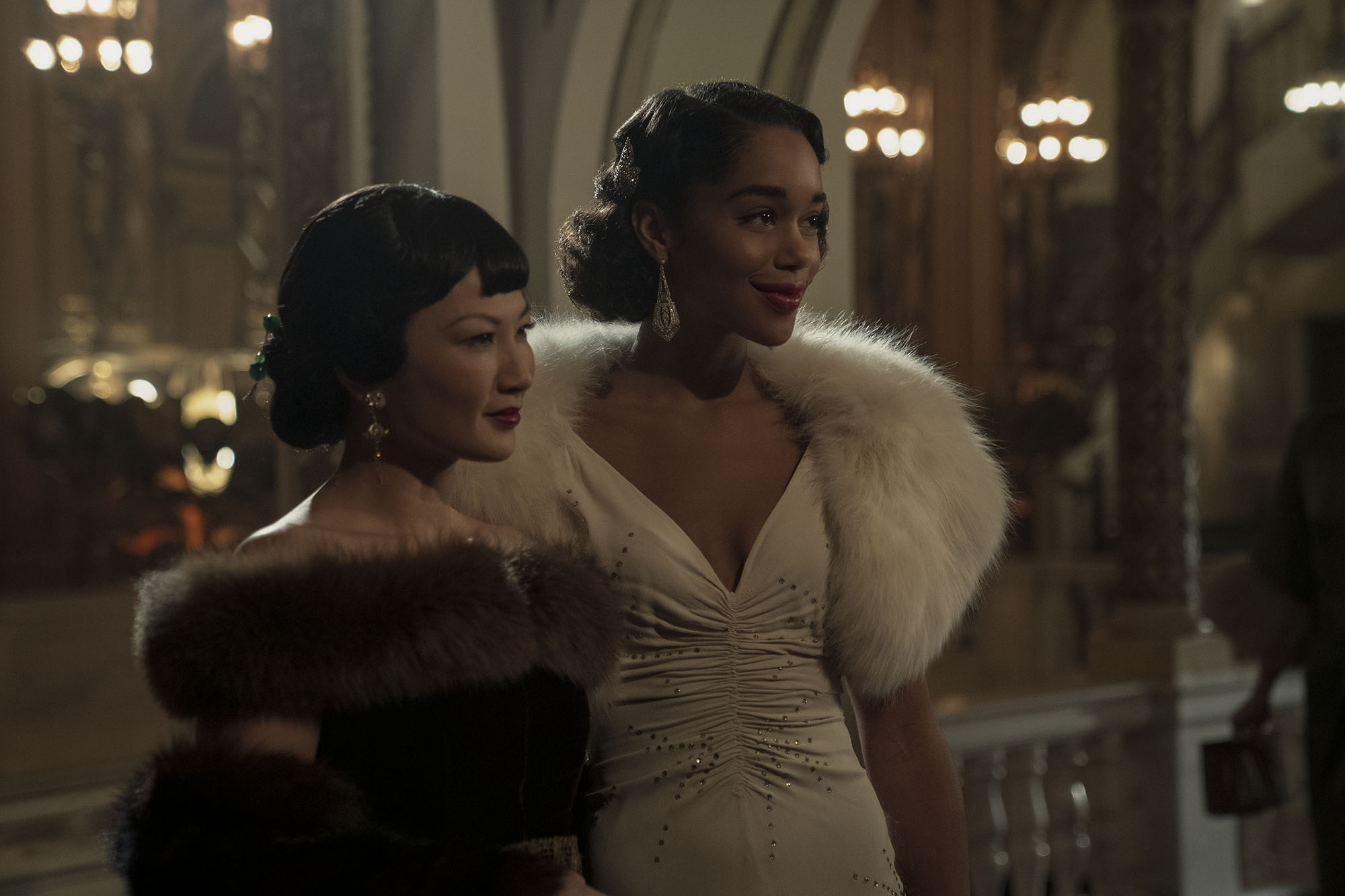

While most characters are fictitious, several, including Jake Picking's Rock Hudson, Michelle Krusiec's Anna May Wong, Queen Latifah's Hattie McDaniel, and Katie McGuinness's Vivien Leigh, were major real-life stars of the age. How do you go about designing, or in some cases re-creating, costumes for people who actually existed?
Were there any historical moments (such as the Academy Awards) that you were compelled to reference, or were you able to take liberties and tailor the costumes to be consistent with the overall vision for the show?
SE: When we were re-creating a character but not an actual moment, we would take liberties. We’d heavily research the style of the character (like Vivien Leigh) and then find the magic in the fitting room with the actor—what garment on the actor feels Vivien.
When we were re-creating real people in real moments like Hattie, Ryan felt it was really important to respect the moment by re-creating it exactly. There were lots of images of Hattie in her dress, but they were all black and white, so we went to our trusted and beloved fashion historian for some help, and she found a series of written accounts describing the color of the dress and cross-referenced that with 1940s colors to make sure that we were indeed re-creating correctly.
With someone like Rock, there really weren’t many images of him before the very late 1940s since he hadn’t get gotten famous, so we researched his style and tried to take it backward to imagine what a Midwestern truck driver who’d be unaware of his star power would have been wearing.
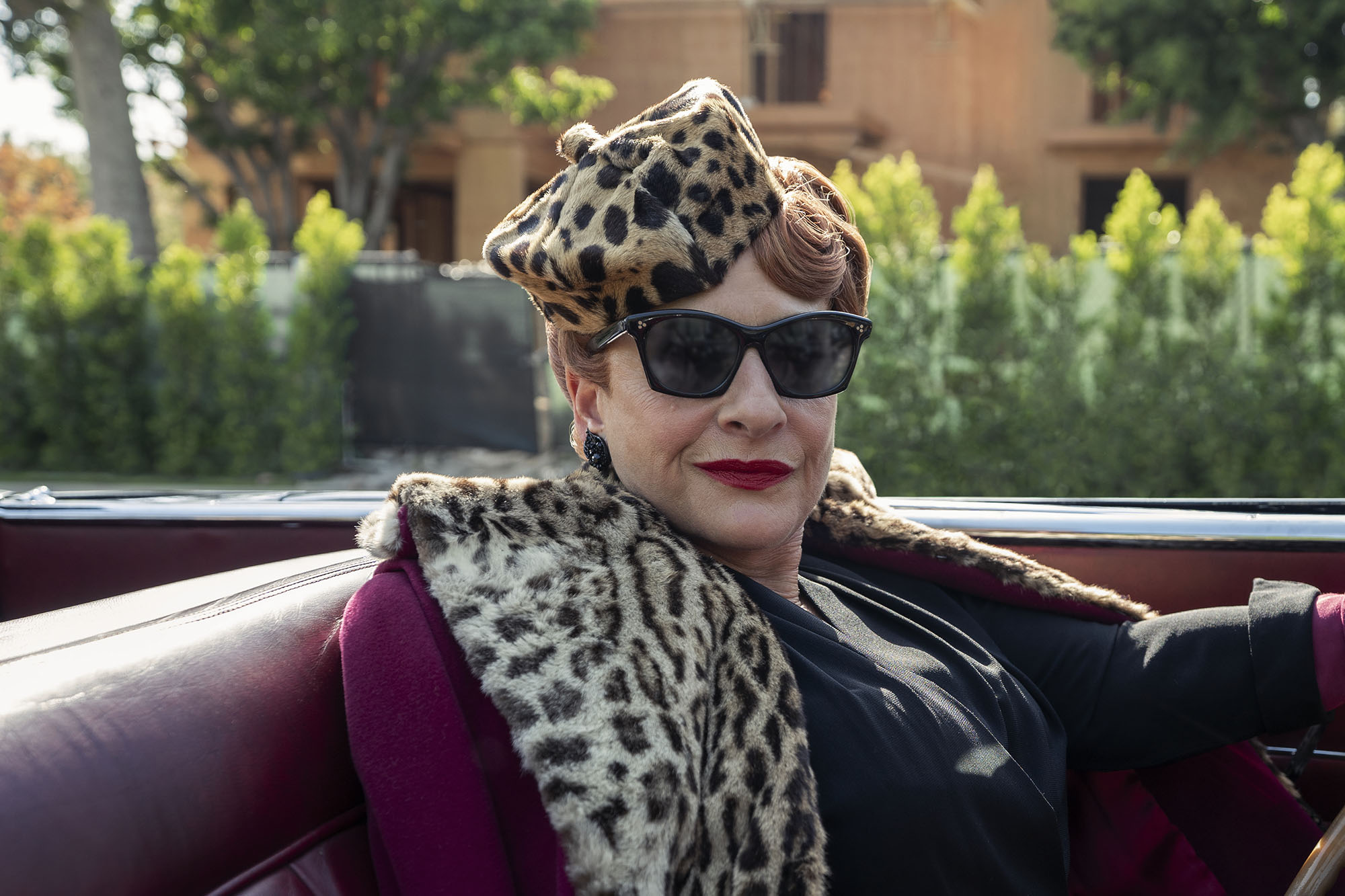

While the entire series is a stunning visual piece, I have to admit Patti LuPone's character, Avis Amberg, is a consistent delight. The hats, the fabrics, the jewelry! What was it like not only designing for a Broadway icon but also creating the look for a powerful female executive in 1940s Hollywood?
LE: Patti has been a "regular” on RMTV shows, and it’s always a delight to get to work with her! This was the first time doing the 1940s period, however. She’s so game for anything, and she was just a dream.
First of all, she can make any costume look good, and she commits, from the period undergarments to the big hats and over-the-top jewelry to the songs she sings to you in the fittings or the big warm smile she gives you at the crack of dawn when you are zipping her into a corset. She’s really passionate and loving and caring and so good at supporting other creatives. It was really special. We want to be Patti when we grow up.

What was it like designing for the male characters? How were the suiting styles of the '40s different than they are today? How did you differentiate between the creatives (Darren Criss's Raymond Ainsley and Jeremy Pope's Archie Coleman), executives, and actors?
SE: Suiting was very different in the 1940s—a much baggier cut, large lapels, big, big shoulders, and high-waisted pants. Amazing but different, and it can take some finessing to get a modern body (tall, long arms and legs and built from working out) into a ’40s silhouette. For some of the characters, we’d nuance a bit, perhaps cutting the legs and jackets a little slimmer so it looked ’40s and sexy to the modern eye and not just an oversize suit.
For the executives, we tried to keep it luxe, luxe, luxe. Dark, rich fabrics, traditional power patterns like pinstripes, crisp shirting, and power accessories—cuff links, tie bars, pocket squares, new hats, and so on.
For the creatives like Darren, Archie, Jack, and Rock, we built more textured layers and a little bit more casual closets. They didn’t have the money, but they had the style. For Darren/Raymond, we kept him in suits but played with more texture, color, and pattern. We’d add a pink vest (an ask directly from the Ryan Murphy brain trust) or a neck scarf. For Archie, we felt he’d really be an artist. He'd be the guy that creates style and a jazz baby. We looked to some of the jazz musicians at the time that would hang out on 52nd Street in NYC. Jeremy looks so good in clothes, so we really played around with more out-there 1940s pieces and patterns and mixing and matching. He’s a creative rule breaker, and that applied to his fashion as well.
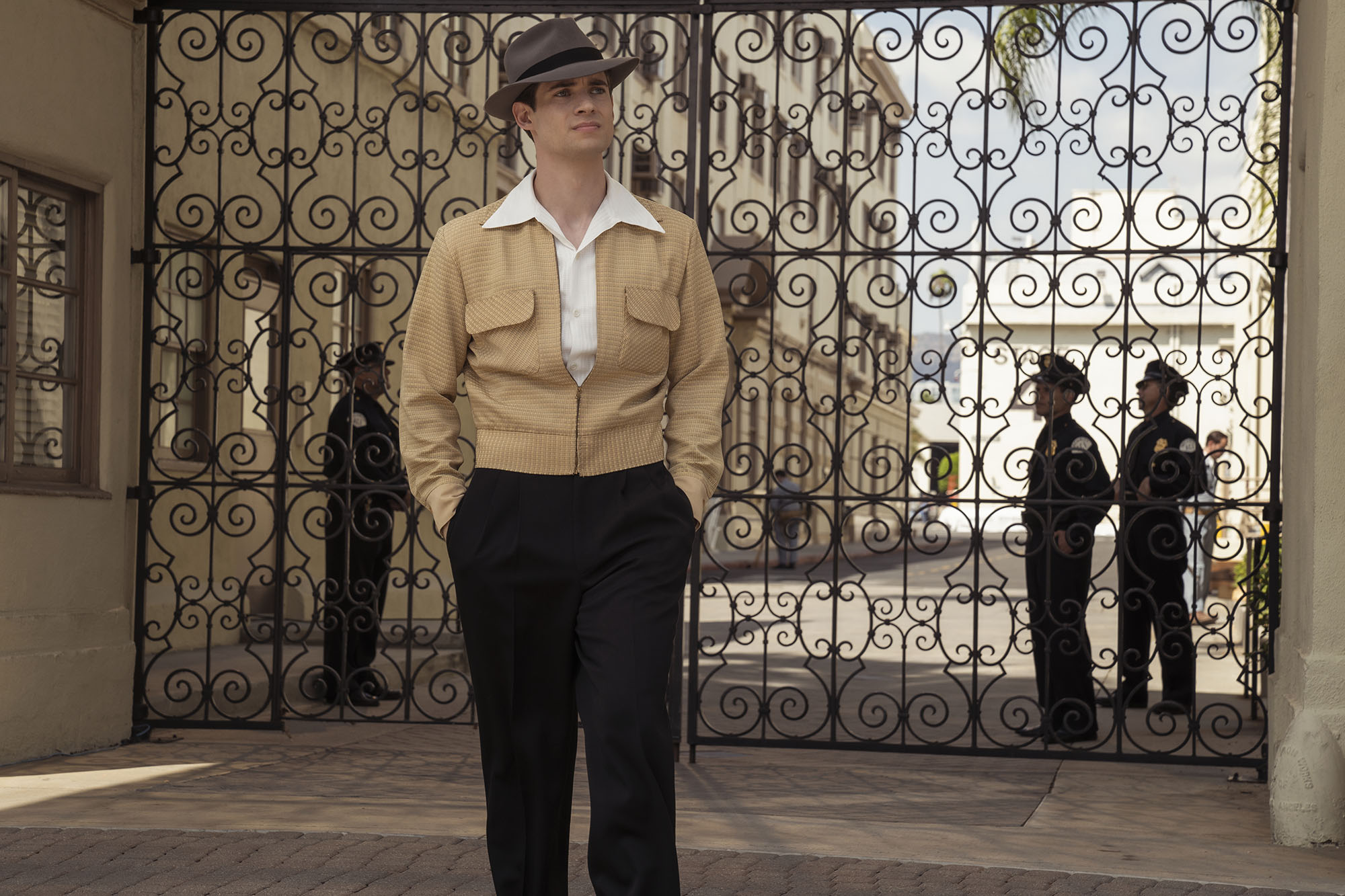

SE: Dressing Jack was a lot of fun. David Corenswet is a lighting bolt. He really loves costumes! Ryan saw him as a young James Dean, so that was our starting point. What would this guy wear who years later would make the jeans and a T-shirt iconic? He’d wear something casual, easy, but that looked like a million bucks, and the very ease of it would make it sexy and all-American. He has a lot of short-sleeve button-front camp shirts opened so you could see a bit of a tank, or a well-fitted knit polo shirt, all-American hottie ’40s style.
Jake/Rock was a historical character, so we did tons of research on the actual Rock Hudson, but images of him didn't start appearing until the very late ’40s/early ’50s, so we had to imagine backward, this guy from the Midwest that had been a truck driver for a living. What would he have been wearing during his rise to fame? We loved the idea of a khaki and some sort of popover shirt, slightly nerdy but actually cool, 1940s version of J.Crew.
Dressing Dylan [McDermott]/Ernie was awesome. Dylan is such a fantastic collaborator. He has so many ideas, and he puts on a costume and brings it to life. His character was very Fred Astaire/Cary Grant. We love him.
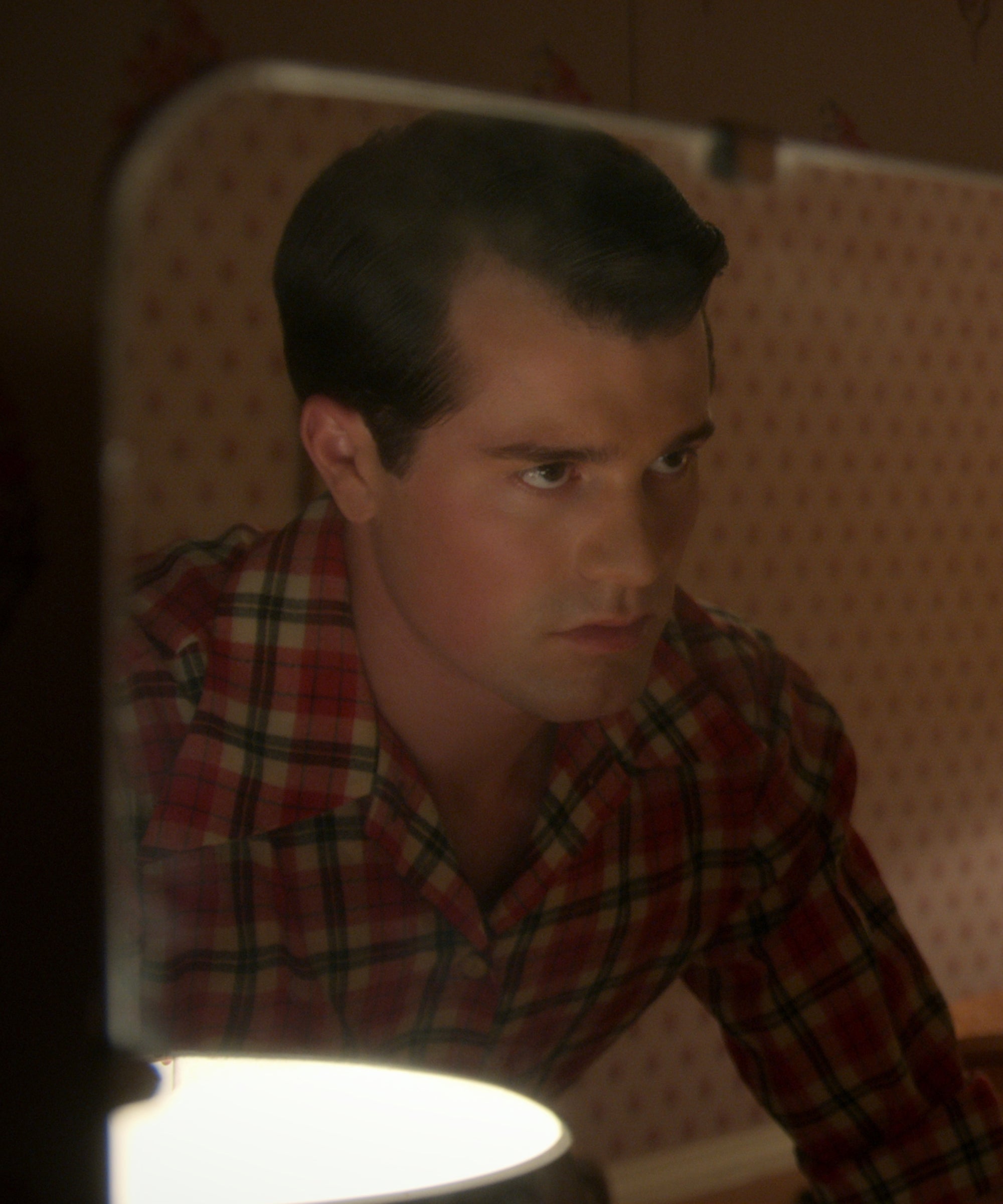

Similar to the contracted ingenues Camille and Claire, Rock Hudson serves as a contrast to fellow aspiring romantic lead, Jack Castello, played by David Corenswet. How did you use costume to convey the differences between these two men vying for A-list roles in Hollywood? Was it more challenging to design for Hudson since he was a real person, or Castello since you were starting from scratch?
SE: We imagined Jack Costello as a young James Dean and Rock Hudson as a young Rock Hudson obviously. Jack was a bit more fashion-forward. He was a little more ’40s version of jeans and T-shirts, and for Rock, we tried to create a bit more of a preppy country bumpkin-ish look but that was cute on him. If it was today, Jack would have been Levi’s and Rock a little more J.Crew.
There are challenges to both. Starting with a real-life character gives you a definitive direction, but then you feel the pressure of creating a connection to history, representing this real human properly. Working on a fictional character has a less definitive direction, but once you dig in and you find your way, that guides your style direction and becomes your North Star for costume choices. Ryan saw Jack as a young James Dean, so once we had that, we were well-oriented.

There are a few memorable nude scenes (and several semi-nude scenes) throughout the series. How does the costume department play a role when clothing requirements are minimal or nonexistent?
LE: We were super fortunate to have a great intimacy coordinator, which takes much of the load off of costumes, but costumes do play a role in nude scenes as we supply all possible garments and padding that will make the actors feel more comfortable. I think our set people also often just give more support and a guarantee of a safe space, but again, we had a great intimacy coordinator who had really good relationships with all the actors, and he did a lot of the heavy lifting on this one. Also, when it's a scene where an actor goes from dressed to nude or clothing comes off or there’s lingerie, that can add a technical challenge. How do we make these buttons easy to unbutton? How do we make this super-sexy lingerie ensure coverage, and so on?
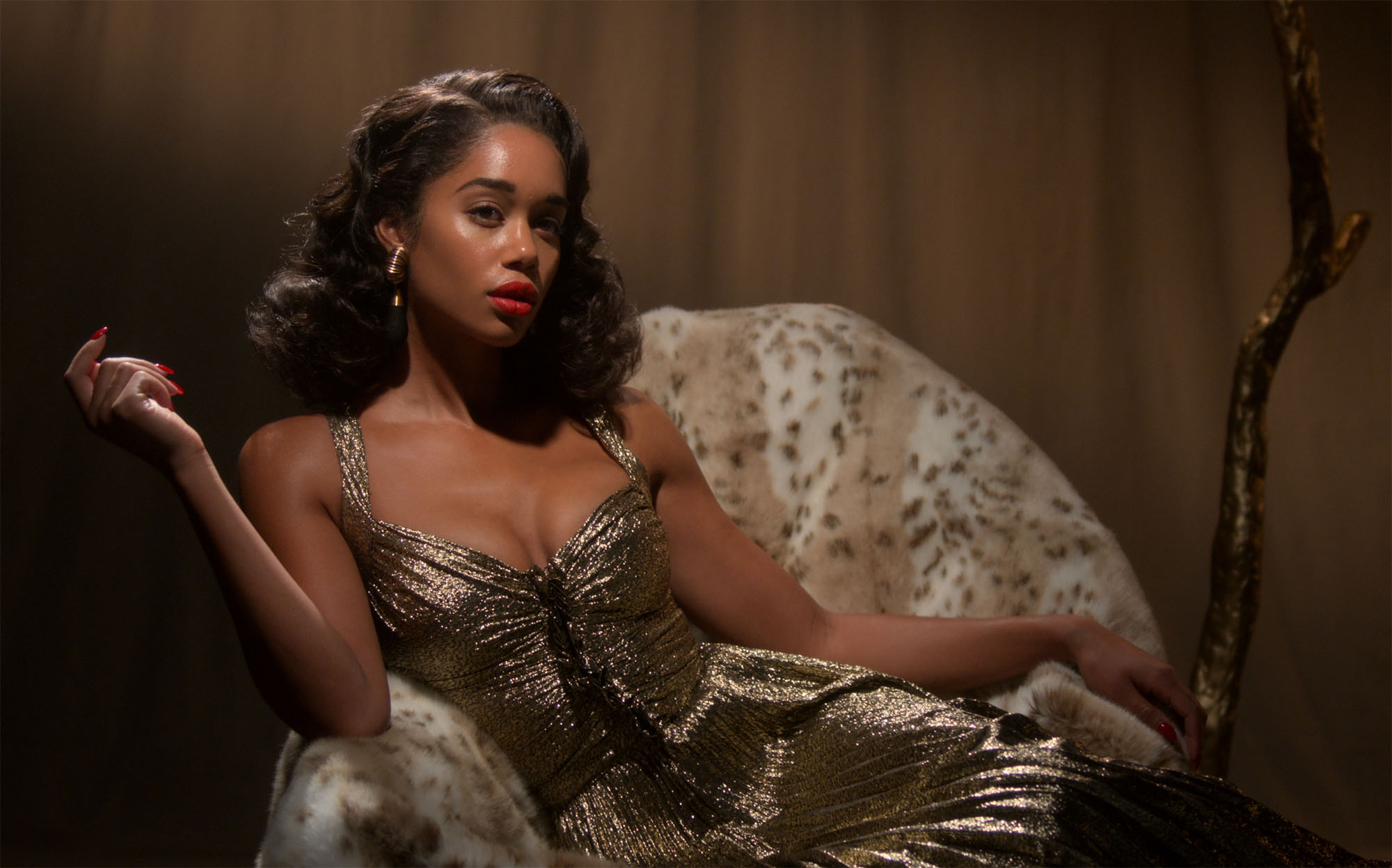
Lingerie and undergarments were significantly different in the '40s than they are today. Did you custom-design the lingerie we see? Were they an accurate reflection of the styles of the period, using the same materials that would have been available then?
In an effort to achieve the cinched-waist figure that was the Hollywood ideal, were "authentic" undergarments used even when characters were fully clothed?
LE: More or less, we used traditional foundations, and the ones we made that would be seen we tried to keep as true to the period as possible. Yes, most of the actors wore the traditional 1940s undergarments, but they were reproduction corsets/girdles, garter belts, and seamed stockings. Rago makes great repro girdles. Stockings were actually surprisingly hard to keep in stock, but we ordered seamed stockings from Berkshire and What Katie Did. We’d go to What Katie Did for underwear and a couple other contemporary places that still carry more traditional style bras and undies.
Regarding lingerie, often that was period or something that our brilliant cutter fitter, Joanne Mills, made using antique lace and silky fabrics, as they would have been in the ’40s.
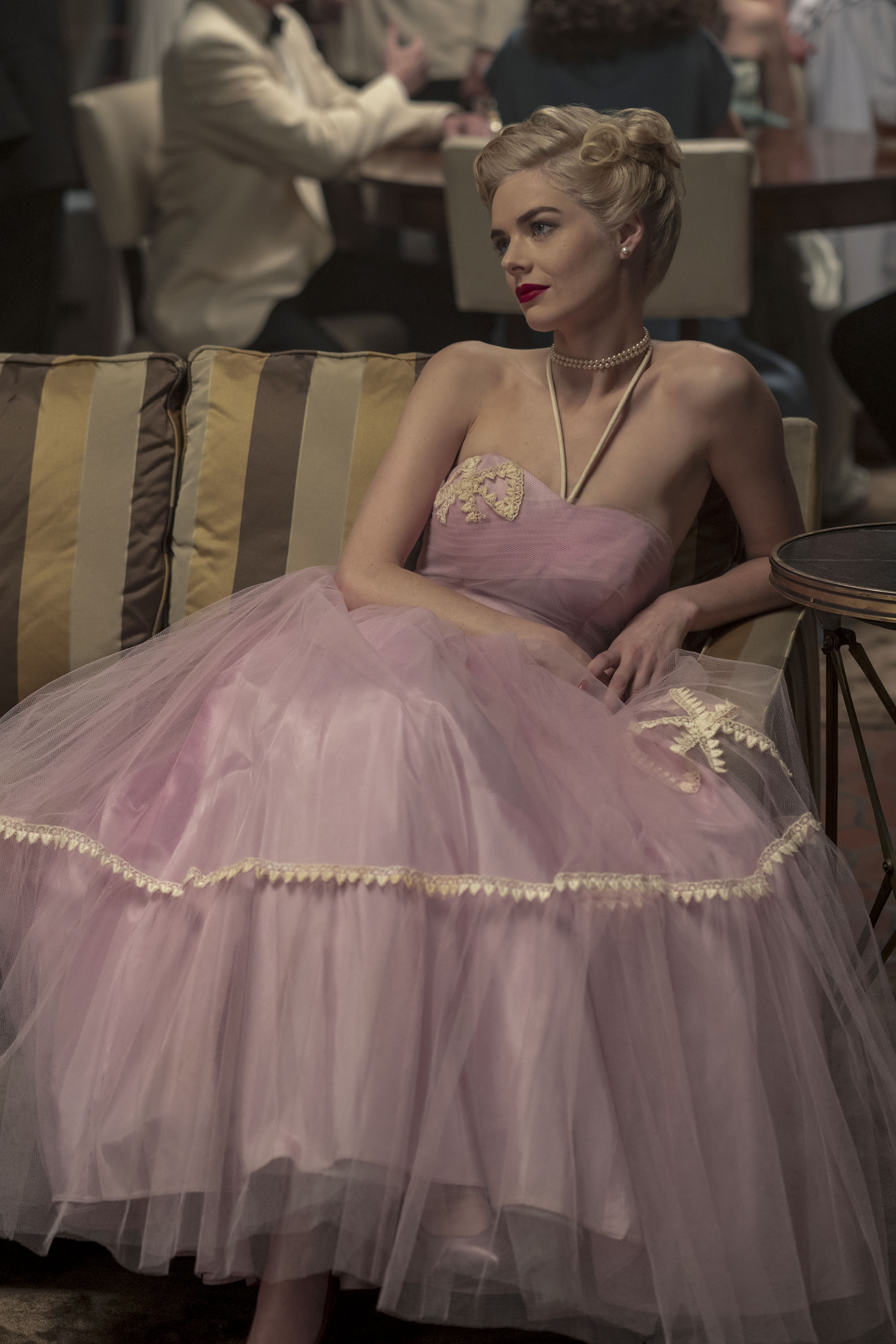

What is your favorite costume from the series and why?
SE: Can’t say—I don’t have a favorite. I loved so many. I think that the Oscars were really special, and all those actors endured some not-so-comfy costumes for long hours and made them look amazing. We tortured poor Laura Harrier, but she gave us everything because we loved that dress! Holland was a real favorite. Her own mom was an inspiration for her character’s. Patti, Jeremy, Darren, David, and Dylan were great. Everyone, everyone just made the costumes so special.
LE: The gas station uniforms were pretty special. Ryan, Sarah, and I had a good time designing those and worked really hard on getting the 1940s silhouette right for our guys. Coordinating the colors, finding the right fabrics, that took a while; deciding the hats and developing the jackets, we love those jackets. We also got all the tie bars and belt buckles custom-made.

Were there any specific outfits or accessories you or the cast were able to keep after filming?
LE: We don’t keep costumes unless it’s for the overall RMTV costume stock. Some of the cast asked for their costumes, yes, and Ryan is doing a benefit auction with some of the accessories and clothes kept aside. I wish I had kept a gas station uniform jacket!
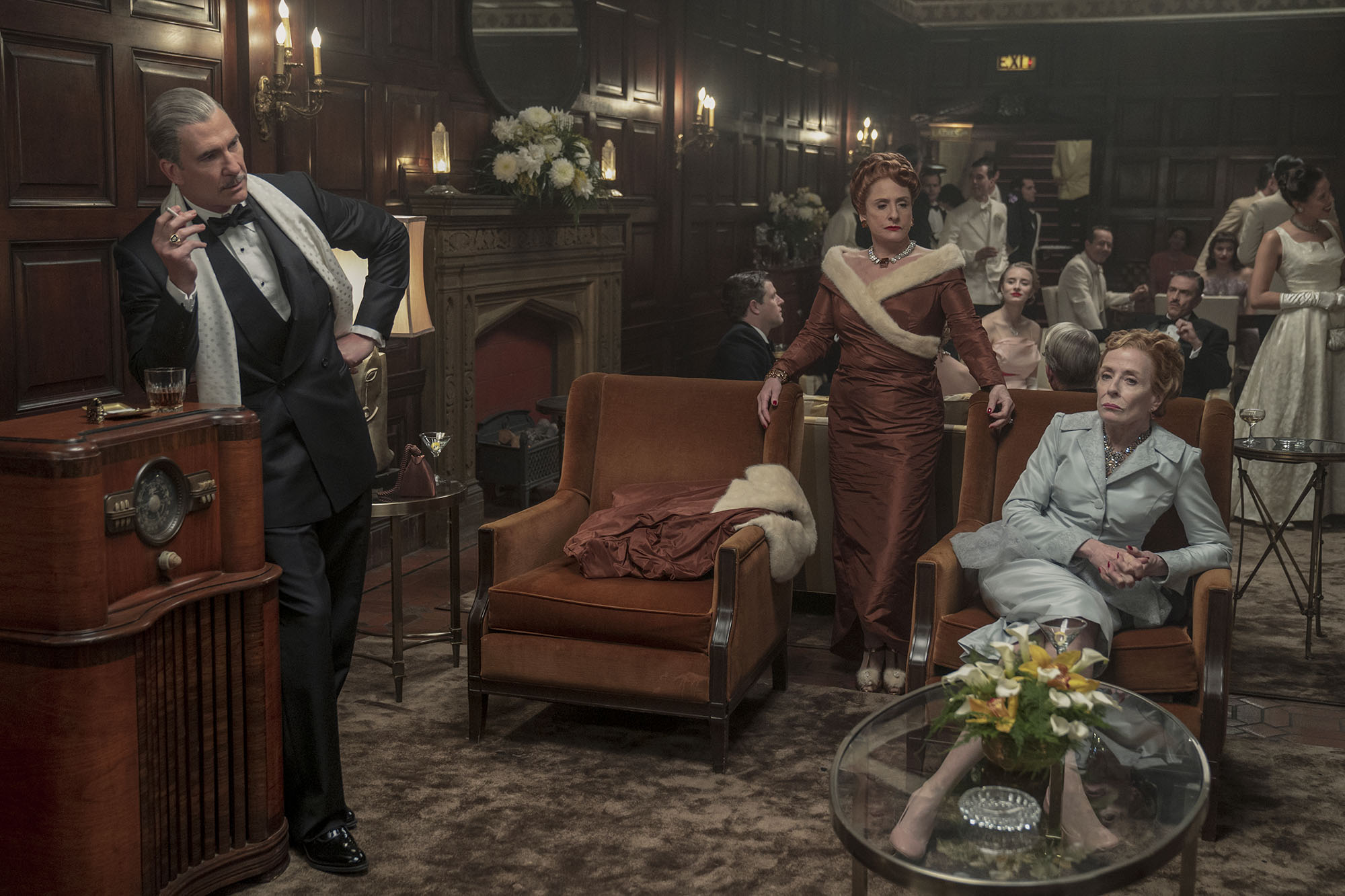
For fellow fans of Hollywood's Golden age, can you recommend any films or movies that helped to inform your understanding of the period?
SE: Yes! Casablanca; Dark Passage; Woman of the Year; Now, Voyager; The Lady Eve; Notorious; Killers; The Maltese Falcon; Rope; Gentleman’s Agreement; The Lost Weekend; Gilda; A Letter to Three Wives; The Red Shoes; and so many more!
But that's a good start…
Up next: All Dressed Up With Nowhere to Go: A Zoom Photo Shoot With Laura Harrier
Drew Elovitz is originally from Pittsburgh, Pennsylvania, but has spent the last decade living and working in New York City. She earned a master's degree in media and popular culture from New York University, then began her career on the internet as the Twitter voice of Barbie. She worked previously at Who What Wear as the director of content strategy and also spent several years leading the social media teams at Teen Vogue and Entertainment Weekly. You'll find her byline on the site around topics such as celebrity fashion, must-have basics, beauty favorites (particularly nail polish), and wellness tips and tricks.
-
 In Conversation With Hollywood Rising Star Mari Yamamoto
In Conversation With Hollywood Rising Star Mari YamamotoThe Rental Family actress on human connection, working with her idols, and writing her own roles.
-
 The Pro Golfer and Vintage Miu Miu Collector Transforming F1 Paddocks Into Runways
The Pro Golfer and Vintage Miu Miu Collector Transforming F1 Paddocks Into RunwaysSpotted: JW Anderson's pigeon bag, Tabi pumps, and the iconic Hermès Bolide on Wheels.
-
 The Musical Metamorphosis of Diana Silvers
The Musical Metamorphosis of Diana SilversThe actress and model is adding "musician" to her résumé with her breakout album, From Another Room.
-
 Famke Janssen Is Hungry for Authenticity in Fashion
Famke Janssen Is Hungry for Authenticity in FashionThe screen icon takes on the role of costume designer for her latest project.
-
 Brittany Snow Is Reclaiming Her Power One Project and Red Carpet Look at a Time
Brittany Snow Is Reclaiming Her Power One Project and Red Carpet Look at a TimeWe're here for the actress's 2025 renaissance.
-
 Abby Elliott Brings Romanticism to the Forefront With Rodarte Premiere Look
Abby Elliott Brings Romanticism to the Forefront With Rodarte Premiere LookA peek inside the All Her Fault and The Bear star's getting-ready suite.
-
 Navy This, Brown That—Sorry, But 99% of the Time, Fashion People Only Wear Leggings in *This* Classic Color
Navy This, Brown That—Sorry, But 99% of the Time, Fashion People Only Wear Leggings in *This* Classic ColorJust ask the L.A. Pilates crowd.
-
 More Jackie Tohn, Please!
More Jackie Tohn, Please!The Nobody Wants This actress is season 2's standout.

